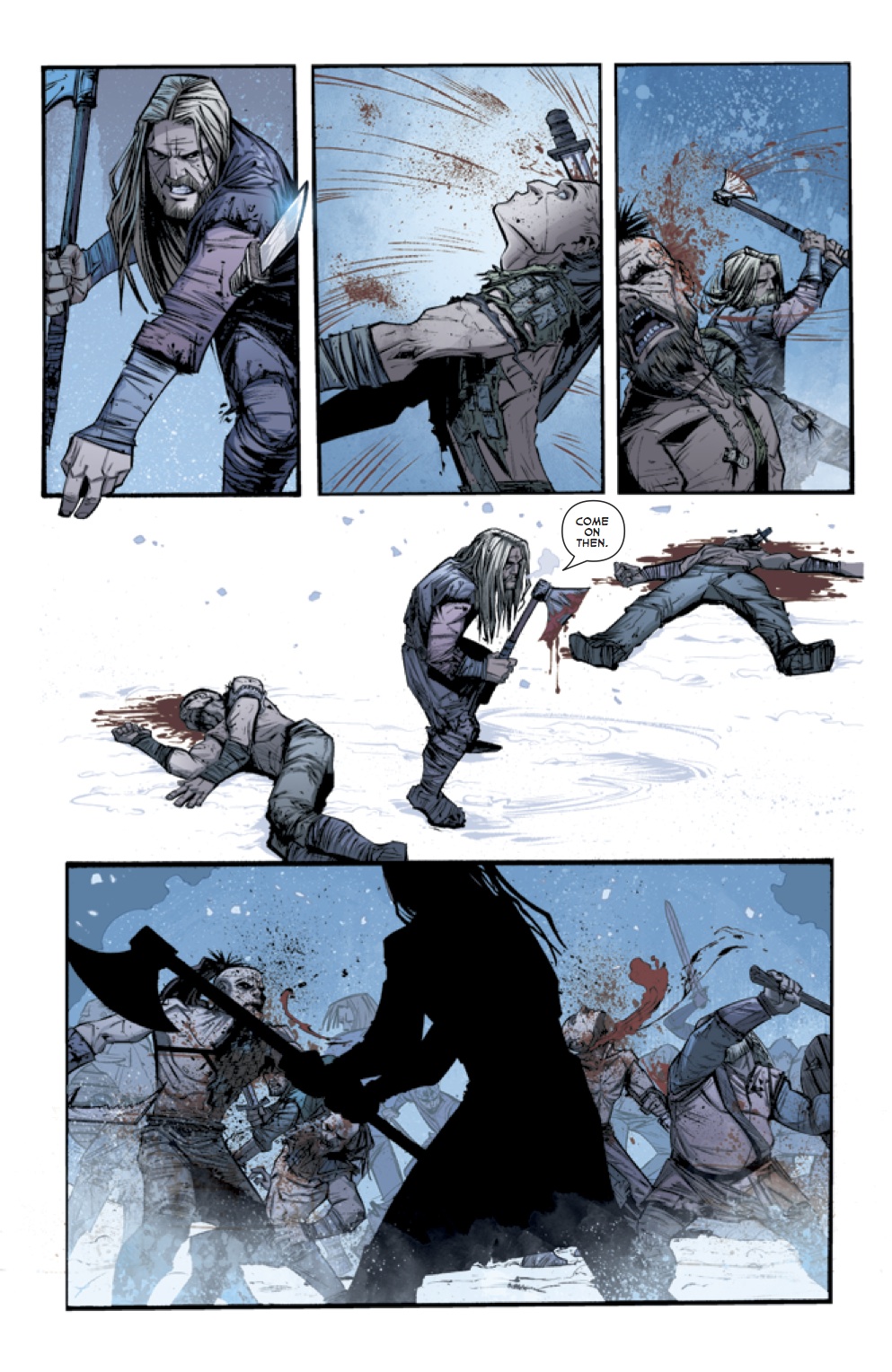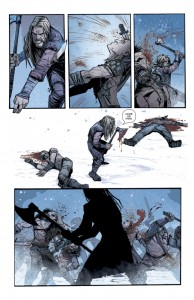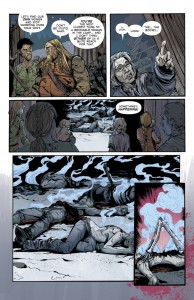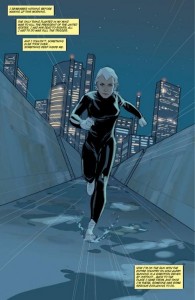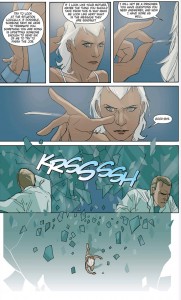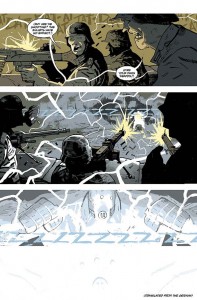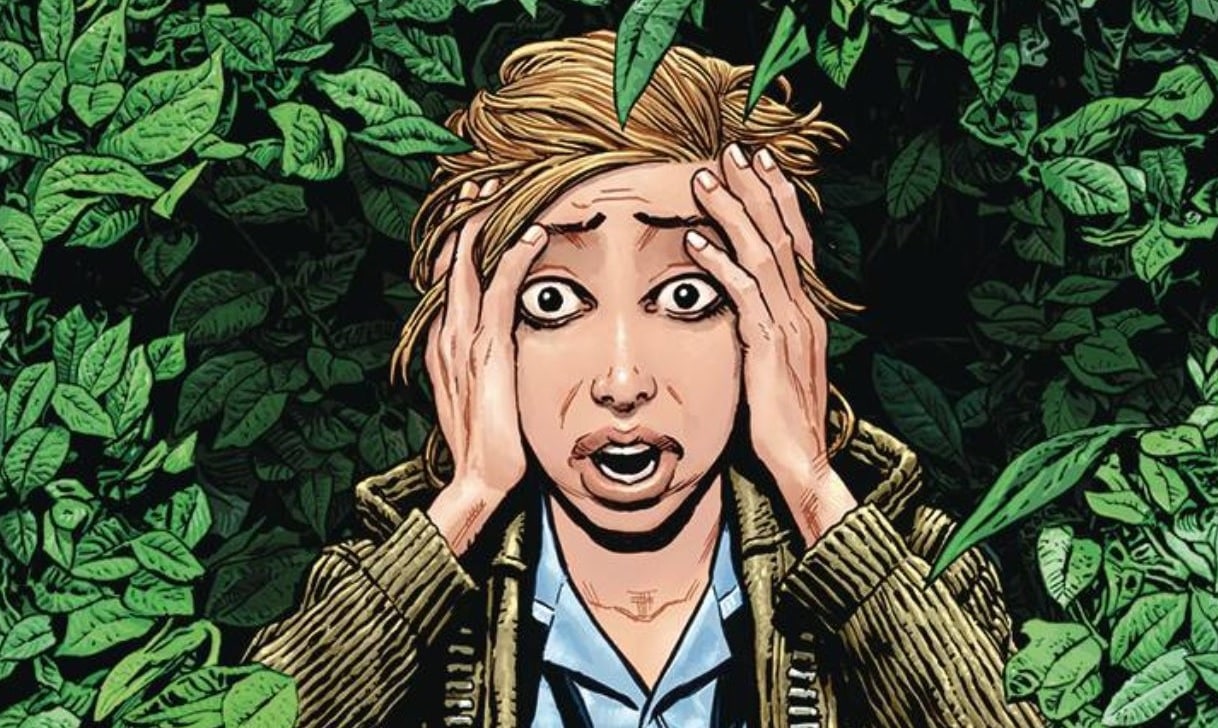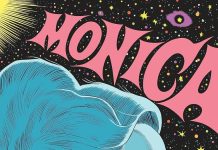I noticed a common feature in the comics I was reading this week, a feature that made them all compelling as stories: the role of the underdog pitted against overwhelming odds. Seeing the psychological reactions of the characters was an important part of the ride, but excellent artwork, particularly in executing fight scenes, left me more than impressed with each one. HELHEIM #1 (out March 6th), TRIGGER GIRL 6 (out March 13th), and SLEDGE-HAMMER 44 (out March 13th) strike a fluid balance between characterization and action, always a kind of brass ring for comics creation, though sometimes a little difficult for readers to come by.
[Spoilers for HELHEIM #1, TRIGGER GIRL 6, and SLEDGE-HAMMER 44 #1 below]
[HELHEIM #1]
HELHEIM, from Oni Press, kicks off a new series, and so has a great deal of storytelling to accomplish in a single issue. It does this with axes, axes, and more axes. Though it’s true there are plenty of axes, there’s also a lot more to HELHEIM, a tale “of the North” featuring what I’ll assume from the title are Vikings. Joelle Jones (FABLES) illustrates the issue, and her style is not only eye-catching but moody. Her characters in profile resemble figures from Viking-age artifacts but also have an angularity to their movement that really establishes the world of HELHEIM. I mentioned fight-scenes. These are equally unique and captivating. Though pseudo-medieval fight scenes are common enough in comics to keep you from really paying attention to the detail of their rendering, Jones breaks down that familiarity through unique panel layouts, occasionally rounded to depict landscape or full-page with overlaid panels to create emphasis. If she impresses with her Vikings, she’s even more at home with her artwork conjuring the undead, which sets up the forthcoming themes of the series well. There’s a kind of epic weight to some of her panels that simply stays with you, a sign of excellent art.
[HELHEIM #1]
Writer Cullen Bunn keeps up the pace of the story with driving action, and combines many of the tropes from medieval sagas without slowing things down. He establishes the role of kin relationships straight off the bat as central hero Rikard tries to save his wounded son, but ultimately has to leave the corpse behind, and then engages with both his father and other relatives at their timber fort under siege. Family relationships make for good drama, particularly in 580 AD. This forms a large part of the psychology of Rikard in his role as protector, but also as father and son. But it’s the supernatural elements Bunn includes that I particularly applaud, from Rikard seeing a vision of his own bleeding ghost predicting his imminent death (this happens in Irish Sagas of the period, and perhaps Viking too), to the rising corpses of his recently slain grotesque foes pursuing him. These are some of the elements that make Viking sagas great in their own right, including blue-faced undead who haunt houses and pound on the roof, calling the cowering inhabitants by name. Bunn brings the most evocative moments of Viking tales to new life, but isn’t afraid to introduce his own developments, like the series premise set up in #1, that Rikard can be resurrected by witchcraft to act as a vengeful Franken-Viking. If the rest of the series shows such careful consideration as this issue, the combination of powerful artwork and strong storytelling will be well worth the read.
[TRIGGER GIRL 6]
TRIGGER GIRL 6, the compilation volume of the series that appeared in the too soon cancelled magazine CREATOR OWNED HEROES, but thankfully presented as a whole by Image, already took fans by storm in 2012, but seeing the series in one unit was entirely worth the wait. Phil Noto’s artwork on the series is simply dazzling, from sleek line-work to color themes. Noto has the uncanny ability to present moments of stillness in the midst of action that creates a sense of vertigo for the reader. Since about two thirds of the story-line involves clone Trigger Girl 6’s attempt to assassinate the president of the USA, hang on tight. The plot calls for handling animals in a majestic, impressive role and Noto proves up to the challenge, too, making you wonder if there’s anything that’s not his forte when it comes to comic art. The pastel hues of the early stages of the story also merge into ethereal jungle settings within any jarring sense of transition. From near-future technology to talking animals, Noto knows the score.
[TRIGGER GIRL 6]
Jimmy Palmiotti and Justin Gray bring us a story in TRIGGER GIRL 6 that defies you to doubt its central truths. In an included interview, the collected volume expresses Palmiotti and Gray’s concern about big corporations, and the increasingly “overpopulation and greed” in modern society that gives weight to the whole TRIGGER GIRL concept. It’s not just a beautifully drawn assassin story (though that would probably be enough to sell the book), but it’s also a commentary on social conscience. The character of Trigger Girl 6 also develops and expands for the reader, drawing us into her psychology. While TG 6 is silent and therefore mysterious in the early stages of the story, after her escape from government interrogation, Palmiotti and Gray also include inner monologue text boxes that emphasize her own internal questions and search for identity. Though this is often a common feature of sci-fi clone stories, it’s always compelling when it’s handled well, and Palmiotti and Gray manage to convey a great deal about her personality in such a brief story arc. What’s most impressive about the story, though, is that the writers bring out their big themes in what’s effectively a single-issue finale as TG 6 discovers the biological haven where she was born and the scientifically enabled talking animals who have created her. It’s a wild idea, but it doesn’t feel forced in the least, and engages with a long history of social commentary and sci-fi literature that reflects on human behavior and finds it lacking. To say the story has heart would be an understatement; it has compassion and concern. The fact that Palmiotti and Gray feel that they can reach comics readers with such a weighty message elevates the medium in all the right ways.
[SLEDGE-HAMMER 44]
SLEDGE-HAMMER 44 #1, from Dark Horse, introduces a character from Mike Mignola and John Arcudi who has his own mysterious origins and motivations. Like a lot of intriguing Dark Horse comics set in the HELLBOY universe, WWII and the Nazi legacy feature, but this story focuses on the role of fighting men and establishes a skillful balance between the fantastic and the historically grounded. Jason Latour’s artwork has a lot to do with the success of this balance. His blend of stylized linework with military detail suggests 1940’s comic art dealing with war, and the fairly unusual (from Dark Horse) sepia and muted tones of Dave Stewart’s color palette set the comic apart as something a little different. It hints that the war, and its own epic aspects, are as important as the heroic figure that the comic introduces: Sledge-Hammer. But for steam-punk and technology fans, there’s also plenty to love in Latour’s artwork. Mike Mignola’s cover art set up the design of Sledge-Hammer’s mechanoid appearance in his characteristic wood-block imprint style, but Latour also brings a sense of the human to Sledgehammer’s anatomy and appearance, from the first panel where he’s introduced, looming large in his army jacket, to his explosive one-man operation fight scenes where he takes a beating from a Nazi robot. The comic has got atmosphere in spades thanks to the artistic team work involved.
[SLEDGE-HAMMER 44]
Mignola and Arcudi also craft a story with universal appeal through grounding the reader in the perspective of soldiers watching the mysterious Sledge-Hammer operation in action, as well as through giving Sledge-Hammer a speaking role even this early in the story-line. He may be a being of few words, but urging the soldiers to leave him behind and save themselves sets Sledge-Hammer up as a classic heroic being, capable of miscalculation (he seems not to have seen the Nazi robot coming), but also of personal sacrifice. It’s also a wise move that Mignola and Arcudi don’t give too much away about Sledge-Hammer’s mentality, leaving the reader to make assumptions and hang on for the next installment to learn more about whether this metal soldier has any other human characteristics, and what exactly motivates his driven actions against the Nazis. It’s a comic staged for a grand entrance of a unique character, and all the better for picking out the details of wartime experience in Europe through secondary characters. Like many projects that Mignola works on, the storytelling feels decompressed to allow the images to tell their own tale, often with only a few panels per page. The comic calls for more dialogue, actually, than many of Mignola’s works, to create a sense of experiencing conflict on the ground during WWII. The story feels particularly unencumbered by having to fit into any specific moment in a wider mythology, and for that reason it has an overpowering sense of being something new, brisk, and somewhat unpredictable. If you read issue #1, it’ll be almost impossible not to follow SLEDGE-HAMMER into its second issue whether due to its lavish homage artwork or its fresh storytelling, but most likely a combination thereof.
[SLEDGE-HAMMER 44]
These three comics display a strikingly high standard for comic artwork, really setting their artists loose to develop an aesthetic appropriate to the worlds they’re creating. It helps that the reader is following central characters into conflict and watching them battle it out against the odds within their own stories. This gives action scenes even more of an edge and also leads the reader deeper into the psychological layers of the storytelling involved. All three comics celebrate the role of the hero, taking traditional elements and redefining them according to the personal vision of their respective creative teams. HELHEIM #1, TRIGGER GIRL 6, and SLEDGE-HAMMER 44 #1 prove that you don’t have to choose between spectacular art or strong storytelling in comics: you can actually find them both in one package if you’re lucky.
Title: HELHEIM #1/Publisher: Oni Press/Creative Team: Cullen Bunn, Writer, Joelle Jones, Illustration, Nick Filardi, Colors, Ed Brisson, Letters
Title: TRIGGER GIRL 6/Publisher: Image Comics/Creative Team: Jimmy Palimiotti, Justin Gray, Writers, Phil Noto, Artwork, Bill Tortolini, Letters, Design
Title: SLEDGE HAMMER 44 #1/Publisher: Dark Horse Comics/ Creative Team: Mike Mignola, John Arcudi, Writers, Jason Latour, Artwork, Dave Stewart, Colors, Clem Robins, Letters
Hannah Means-Shannon writes and blogs about comics for TRIP CITY and Sequart.org and is currently working on books about Neil Gaiman and Alan Moore for Sequart. She is @hannahmenzies on Twitter and hannahmenziesblog on WordPress.


